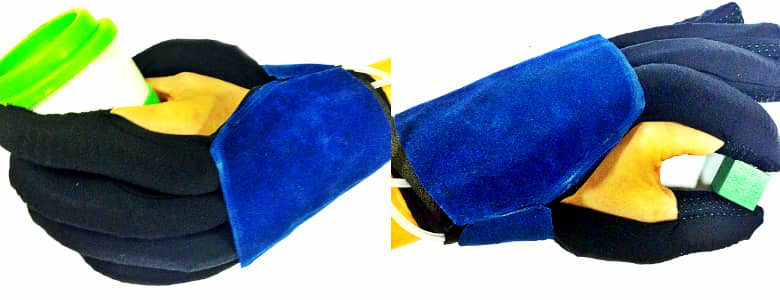Healing power of soft robotics

When 50-year-old Madam Lim experienced a stroke in January this year, the movement of the right side of her body became impaired.
She was hospitalised for three months, during which she underwent an intense rehabilitation regime that involved numerous physiotherapy sessions.
Upon her discharge, she was advised to continue these prescribed exercises at home with the help of a caregiver and family members. Frequent visits back to the hospital were required to monitor her progress.
As the silver tsunami hits Singapore, a growing proportion of our population will, like Madam Lim, experience some form of age-related ailment that compromises mobility.
As recovery is a long process, the strain on healthcare resources is expected to increase exponentially, with demand for occupational therapists and physiotherapists outpacing supply.
Thanks to researchers from the National University of Singapore’s (NUS) Department of Biomedical Engineering, help is at hand — in the form of robotic devices that are making their way into clinics and hospitals.
Although robots have more commonly been deployed in industrial settings such as manufacturing, recent advances in technology have made them more compact and consumer-friendly, and hence better able to move beyond the assembly line into other domains such as healthcare.
On 20 July 2017, the Institute of Engineers Singapore (IES) conferred IES Prestigious Engineering Achievement Awards on two NUS inventions — a soft robotic glove (EsoGlove) and a soft robotic sock (SRS) for physical rehabilitation — in recognition of their innovative use of technology and potential to improve quality of life.
NUS Assistant Professor Raye Yeow, who leads both projects, spoke to TechNews about how soft robotics is fast becoming part of the biomedical scene of the future.
Engineering soft hardware
Robots are often thought of as cold, hard machines with metal joints and rigid movements.
Yet, the robotics being built by Professor Yeow’s team are soft and pliable — the EsoGlove and the SRS both employ soft pneumatic actuators which are, in essence, elastic materials with variable stiffness along their lengths, through which air is pumped to generate movement.
The EsoGlove helps patients with hand motor impairments to perform at-home rehabilitation and day-to-day tasks.
The SRS, meanwhile, is targeted at bedridden patients who are at high risk of deep vein thrombosis and ankle joint contractures due to prolonged immobility; the sock assists them with ankle exercises that promote blood flow and ankle mobility.
“Using low-pressure pneumatics, the EsoGlove can provide finger flexion and extension assistance. A similar technology is used in the SRS which can provide both pull-and-push assistance on the foot to facilitate ankle exercise," said Professor Yeow.
He added that compared with conventional robotics, soft robotics are lightweight, easily customisable to mimic the natural range of movements of human joints and inexpensive to produce.
The greatest challenge the teams faced in developing the two soft robotics devices was in meeting the special clinical needs of stroke patients, said Professor Yeow.
For example, given that such patients tend to have contracted, stiff joints, glove and sock had to be both wearable and functionally safe.
“We designed the glove and sock to make it easy for patients to don independently or with help from a caregiver. The actuators also need to be capable of providing adequate forces to move the fingers and feet while ensuring comfort and safety,” said Professor Yeow.
A helping hand and a leg up
As with all biomedical devices, the EsoGlove and SRS are undergoing extensive tests before the they are widely deployed in hospitals and clinics.
Professor Yeow is working with senior consultant Dr Lim Jeong Hoon, a rehabilitation clinician at the National University Hospital (NUH), to testbed the devices in a clinical trial. The feedback from patients and caregivers has so far been positive.
“Our users have commented that the devices are useful, with great ease of operation and a good comfort level. They are satisfied with our invention and have indicated a strong desire to use them regularly,” said Professor Yeow.
Given these encouraging results, Professor Yeow shared that an NUS startup, Roceso Technologies, has been established to commercialise both inventions and integrate them into home care and healthcare systems.
As Singapore’s first soft robotics company, Roceso Technologies hopes to demonstrate that robots can not only synergise with the functions of healthcare workers, but also help patients recover more quickly by making rehabilitation tasks more convenient and accessible.
“Robotics is necessary to raise the productivity of the healthcare workforce so that they can now manage more patients at any one time,” said Professor Yeow, who is also the scientific adviser to Roceso Technologies.
“Robotics will also enable patients to optimise their therapy time, thereby speeding up their recovery process, potentially saving treatment-related costs and time. The quality of life of patients can be greatly improved through robot-assisted tasks.”
“The IES Prestigious Engineering Achievement Awards have given us strong recognition of our teams’ efforts in developing soft wearable robotics. We are motivated to pursue our soft robotics engineering research further and develop novel wearable technologies to improve healthcare,” he added.

